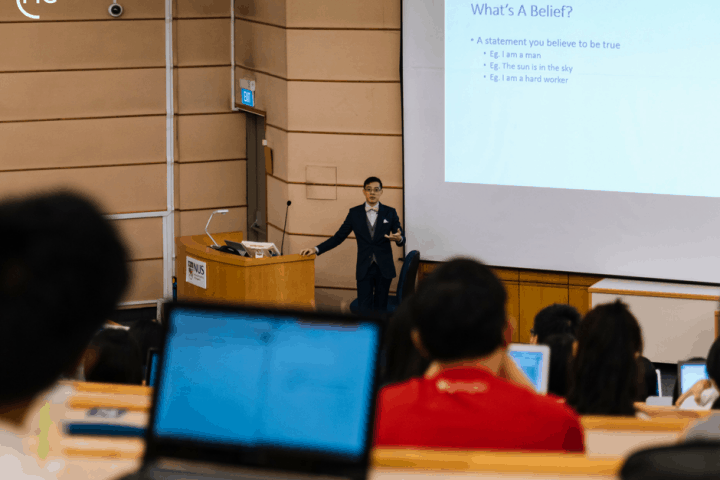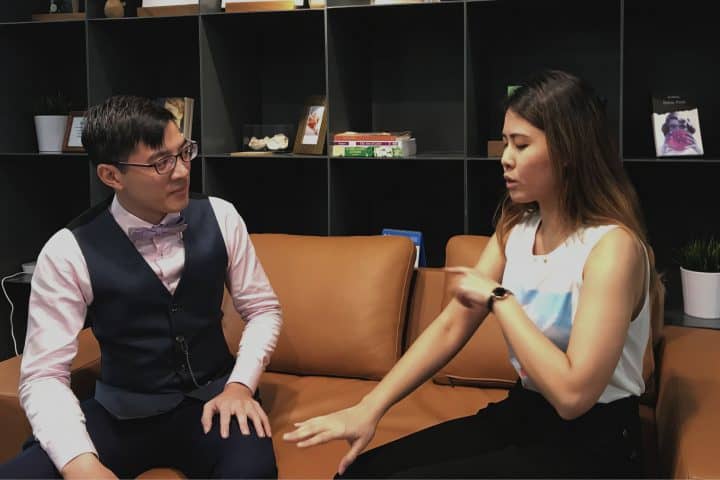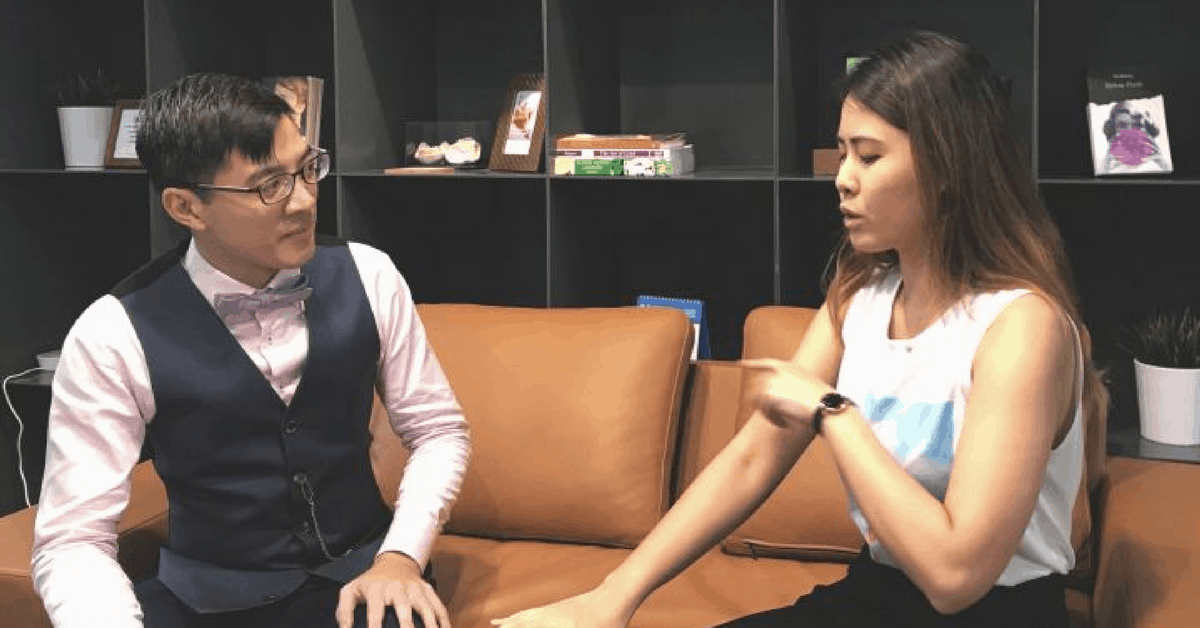When I was asked to interview a hypnotist, I’ll be honest and say I had my doubts. To be fair, we’re talking more “therapist” than Las Vegas magician that’ll have you clucking like a chicken on stage—but you catch my drift.
There were only two things I was certain of:
1) that we’d meet at his office
2) that I’d be “hypnotised” at the end of our interview
Neither of which was much to go on.
The day came and we met at his office, a co-working space opposite Bugis Junction. I’d made the last-minute decision to call a girl-friend to join me for the interview—the more the better right?
To be honest, I’m not sure what I’d expected McKing to be like – after all, I’d never met a hypnotist, let alone seen one beyond the rectangular edges of my television. But he was warm, inviting and refreshingly upfront with his responses.
How It Began

At 29, McKing has already had multiple brushes with death. Which however unfortunate, has led him to the art of hypnosis.
“When I was 20 years old, my lung burst in my sleep. I woke up with breathing difficulties, but I had to give a presentation in school.”
“At the time I was studying Child Psychology and Early Education in Ngee Ann Poly, it was a Tuesday—first year, first term, last week.” He recalls this with the accuracy of someone who had his first near-death experience.
He made it to class, although he hardly made it through his presentation before finding himself incapable of speaking or breathing. “I could feel pain vibrating through my chest, every time I breathed it felt like someone was stabbing me in my back.”
After succumbing to the pain, he was admitted to the A&E. A doctor would soon come to show him an image of his nugget-sized lung that had collapsed the night before.
“He told me I’d die in the next few days or in the next few minutes when the air crushes my heart unless I undergo a procedure” McKing lamented calmly.
He then puts his story on hold to explain how hypnosis works.

“We have 2 minds; the conscious and unconscious mind” he explains.
“The conscious mind deals with what we’re knowingly aware of, like the sound of my voice, while the unconscious mind acts on its own; controlling your heartbeat, and being aware of surroundings that you don’t even see.”
Our conscious minds act as gatekeepers—we can choose to “open” and accept an idea or “close” and reject it. “When you open the door, the idea goes into your unconscious mind and once it’s there it acts like a sponge or a computer program, it just runs on its own.”
“I’m not able to ‘hypnotise’ people because I went for a course,” he says frankly.
“We’re all hypnotists, to ourselves and the people around us. Your first hypnotists are your parents, teachers are your second.”
A lot of times this is done subtly, but McKing’s encounter in the A&E had been a case of accidental “shock hypnosis”.
Hypnotists generally use shock hypnosis as a form of entertainment; like when they snap their fingers and make an audience member fall asleep.
“What we do is shock the mind, and in that moment your conscious mind’s gates go down so suggestions can be slipped straight in” he explains.

“When the doctor told me I was going to die, I went into shock and in that state, my mind was vulnerable and the suggestion I received was ‘you will die’.”
Though he survived the ordeal, McKing would soon discover that his mind had linked his botched presentation to the idea of death – every time he gave a presentation, he’d suffer a mental and physical breakdown.
“The mind and body are more closely linked than people realise” he goes on, “each time I gave a presentation, my physical body “died” along with my mind.”
He’d turned frail, his fingernails had turned purple and soon enough he slipped into depression.
How Hypnosis Heals
Call it fate or plain luck, but in the years to come, McKing would meet someone that would steer him down a path of recovery.
Through this process of healing, his interest in holistic health grew and one serendipitous day, he found a Facebook advertisement for a Neuro Linguistic Programming course that claimed to promote holistic health.

“After attending the course I realised that what I’d been suffering from was Post Traumatic Stress Disorder (PTSD) and that there were techniques to fix it” he recalls.
“I decided to attend a second mastery course to kind of ‘cure myself, and over the span of these courses, one of the trainers told me I’d been changing, like coming out of my shell.”
He shared his story with his trainer who offered to help him resolve his problems if he’d agree to be part of a demonstration for the class. “It was a very emotional but very healing process,” he remarked.
“It was a walking hypnosis technique where you ‘walk’ physically and mentally back in time in your memories, and you mentally separate yourself the timeline’s events to distance yourself from the emotions.”
He laughs as he recalls dramatics of it all, “But in my case, the connection was so strong. Can you imagine I walked the whole distance of an auditorium just crying and crying? So my trainer told me to put 3 doors between myself and these memories, and I’d imagined these huge doors with eye sensors and all these security locks. After a while, I started to calm down and heal.”
I suppose it only makes sense that this pushed him to where he is now. As an advocate of how much the mind can heal the body, he started his own practice to help others with their issues, however big or small.
Unlike most hypnotists you’d find in Singapore, McKing doesn’t believe his clients should have to visit him a handful of times to resolve an issue.
“Traditional hypnotists believe you have to go into a deep state of hypnosis for the suggestions work – which isn’t wrong per se. But once it gets to that state, the suggestions or “solutions” are coming from the hypnotist,” he points out.
“But what if the problem is a circle and the hypnotist’s solution is a square? There’s always different solutions, though the problem may look the same.”
“If you’re lucky it gets resolved, but if you’re not, even 6 consultations won’t help you because it’s just a trial and error process.”
“My style is more conversational style hypnosis, let me give you an example.” He begins to explain as he adjusts himself in his seat. “This guy came in to resolve his procrastination and he told me he sees procrastination as a huge barrier— like a brick wall.”
“So I asked him why does he think so? And he tells me the moment I asked him that question, the barrier turned into a sun that was growing bigger and bigger until it merged with his body.”
McKing tells us his client was seated completely still during this 15-minute interaction but claimed that he felt the energy of the sun coursing through his veins. 3 days later, his client had spent each day since their session catching up on work he’d put off.
Being Hypnotised

For the next hour or so he tells us about cases of distracted children, businessmen looking for greater success, depression, letting go and seeking long-lost companions.
In a lot of these examples he’d used a method called “Dynamic Mental Imagery” (DMI) to explore the unconscious mind regarding a certain “problem”— a method I’d be trying out in a few moments.
As I sat in his office, walls made completely out of glass, I started to feel nervous, but definitely curious. After all, I’d heard so many success stories in the past hour.
McKing assured me that the demonstration was just to let me get a feel for it, but asks if I have anything I’d want to resolve.
I mull over it for a minute and succumb to the possibility of free therapy. I tell him I’d like to be more independent, and he agrees to help me explore that possibility.
It begins normally, I breathe deeply, try to relax and struggle to stop thinking about a million things at once. There’s a long pause before McKing whispers in a low controlled tone “Now imagine a safe place.”
And as if my mind were on auto-pilot, it did instantaneously.
He asks me what I see and I tell him, “Trees, flowers and a pond. I think I’m in a park but I’m alone.” I tell him I’m wading in the pond, and he asks me if I see a door of some sort—the door to my unconscious mind of course.
Well, I didn’t. But as I spoke to him I felt myself sink deeper into the pond that was supposed to be as shallow as a baby pool.
Before I knew it I was in a carriage—yes, I’m talking horse-drawn with wooden wheels and everything. The only catch was that I had no idea where it was going, and no one was driving.
McKing probed me about my surroundings and what the carriage looked like to try to gather some understanding of the situation, but I hadn’t the faintest clue.
I’m not gonna lie – at this point I was starting to get anxious; I had no idea where I was going or how to get out of it. “Why don’t you ask the horses where they’re going.” McKing suggested calmly. Without hesitation, I thought, “home”.
I was immediately transported to my childhood home, but unlike usual memories, everything was extremely vivid.
The placement, the colours, even the photographs hanging on the wall—they were all there just as I remembered.
I walked through the familiar apartment as if I were there right then.
I see my mother standing beside the huge closet that used to stand behind our maroon leather sofa and before I knew it I was spectating memories I’d forgotten I’d had.
McKing lets me take my time with this, and tells me that I don’t have to tell him what I see if I don’t want to, so I don’t.
Strangely enough, it was a pretty emotional experience for me, but when I was ready for it to end, he led me out of it as seamlessly as he’d led me into it.
I was still trying to wrap my head around what had just happened so I urged my friend to give it a go. She laughed nervously but was intrigued enough to have a go at being a guinea pig—all in the name of journalism.

She agrees to let McKing try some arm levitation experiments on her while I sit by and watch, pen and paper ready. His “Dictionary Balloon” test starts with her holding both her palms over her lap.
He tells her to breathe deeply and focus on her hands as he suggests slowly that one holds a heavy dictionary while the other is tied to a balloon that is lifting it higher and higher.
I sat patiently watching both her hands quiver as one drifted higher and the other slowly sank.
We laugh nervously, unsure of what’s happening, and they even make small talk while her hands continued to move further apart. He brings her out of it and I can’t help but exclaim “Oh my god how was it?”
Somewhat bewildered, she says:
“It’s kind of surreal, my arms were moving but I felt like I wasn’t controlling them but I could still hold a conversation?”
Now she’s really curious and has a go at his arm levitation test.
It’s similar to the one before but now with only one hand. It begins the same – with deep breaths, focus and some subtle suggestions from McKing.
I watch intently once again, holding my breath as her hand floats higher and higher till it’s almost at her chest. McKing asks her if she’d like to bring her hand back down and she says yes.
With a few more deep breaths and instructions, she places her hand back on her knee and starts laughing nervously again.
“Was it different from the other?” I asked after we’d left. “My focus was more intense it was like I was in my own bubble,” she replied, still in awe.
“Everything around me faded out, even his voice sounded muffled. But after my hand touched my lap it was like the bubble popped and my mind felt clear and refreshed.”
We make more small talk after this, feeling as comfortable as you can with someone you’ve just trusted to hypnotise you. McKing walks us out of the office, we shake hands and say thank you and go on our usual way.
A few days later, I receive a message from McKing. I wonder what it’s about, almost forgetting that I’d asked him to help me resolve something just a few days before.
I admitted I felt different, but I wasn’t sure if it was just something I’d been forcibly telling myself.
He assures me that it’s normal to try to rationalize how the unconscious mind works, but if I’m happy with the way I’m feeling, I could just accept the change and move forward.
I thank him and tell him I will, and so I have.
To find out more about McKing, visit his website, Instagram or Facebook page.


















